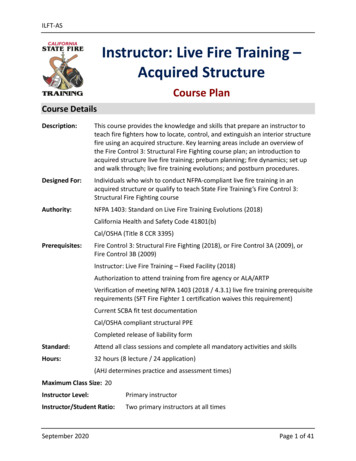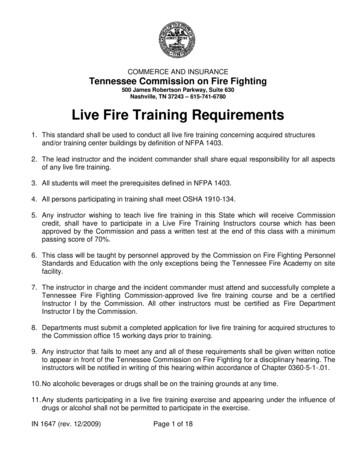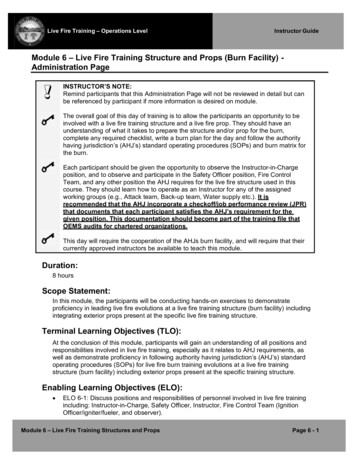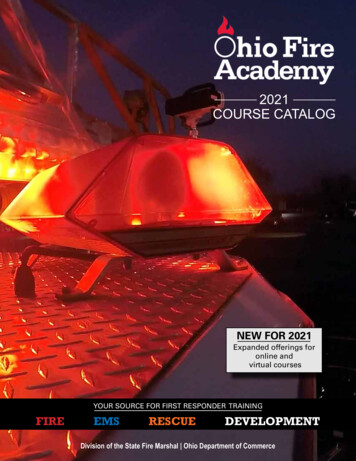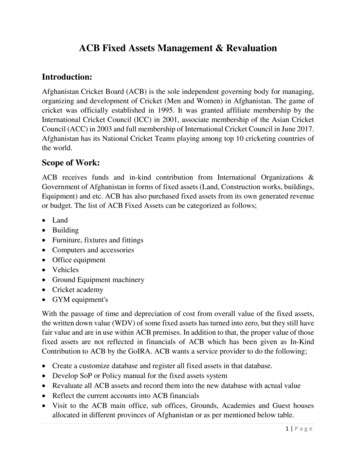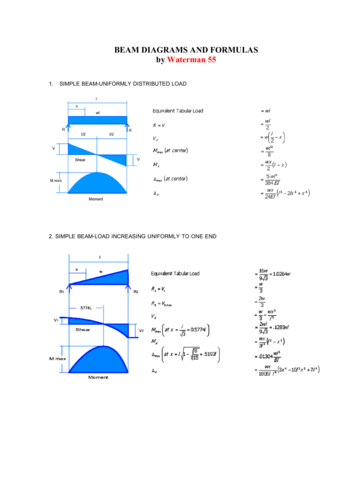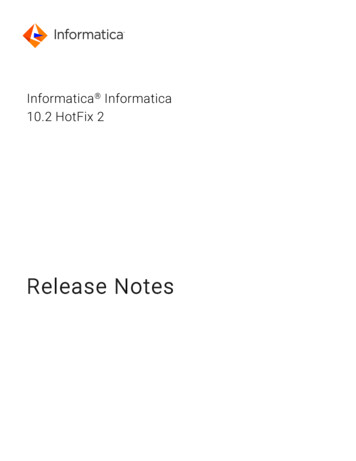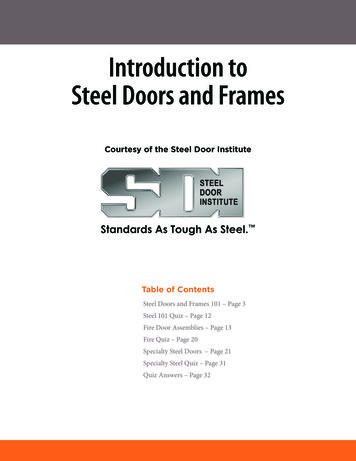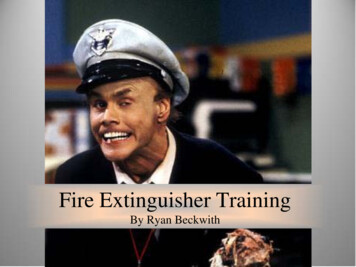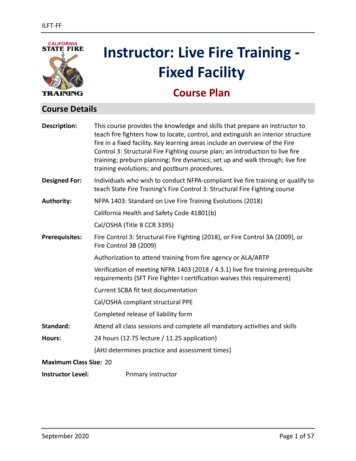
Transcription
ILFT-FFInstructor: Live Fire Training Fixed FacilityCourse PlanCourse DetailsDescription:This course provides the knowledge and skills that prepare an instructor toteach fire fighters how to locate, control, and extinguish an interior structurefire in a fixed facility. Key learning areas include an overview of the FireControl 3: Structural Fire Fighting course plan; an introduction to live firetraining; preburn planning; fire dynamics; set up and walk through; live firetraining evolutions; and postburn procedures.Designed For:Individuals who wish to conduct NFPA-compliant live fire training or qualify toteach State Fire Training’s Fire Control 3: Structural Fire Fighting courseAuthority:NFPA 1403: Standard on Live Fire Training Evolutions (2018)California Health and Safety Code 41801(b)Cal/OSHA (Title 8 CCR 3395)Prerequisites:Fire Control 3: Structural Fire Fighting (2018), or Fire Control 3A (2009), orFire Control 3B (2009)Authorization to attend training from fire agency or ALA/ARTPVerification of meeting NFPA 1403 (2018 / 4.3.1) live fire training prerequisiterequirements (SFT Fire Fighter I certification waives this requirement)Current SCBA fit test documentationCal/OSHA compliant structural PPECompleted release of liability formStandard:Attend all class sessions and complete all mandatory activities and skillsHours:24 hours (12.75 lecture / 11.25 application)(AHJ determines practice and assessment times)Maximum Class Size: 20Instructor Level:September 2020Primary instructorPage 1 of 57
ILFT-FFInstructor/Student Ratio:Two primary instructors at all timesAdditional requirements (per NFPA 1403) One instructor for each functional crew of five studentsOne instructor for each backup lineOne additional instructor for each additional functionalassignmentRestrictions:See Facilities, Equipment, and Personnel requirements (page 5)SFT Designation:FSTEPSeptember 2020Page 2 of 57
ILFT-FFTable of ContentsRequired Resources. 5Instructor Resources . 5Online Instructor Resources. 5Student (Instructor Trainee) Resources . 6Facilities, Equipment, and Personnel . 7Time Table . 9Time Table Key . 10Unit 1: Introduction . 12Topic 1-1: Orientation and Administration . 12Unit 2: Introduction to Fire Control 3: Structural Fire Fighting. 13Topic 2-1: Course Plan. 13Topic 2-2: Instructor Requirements . 14Topic 2-3: Student Requirements. 16Unit 3: Introduction to Live Fire Training . 17Topic 3-1: NFPA Standards and Legal Considerations . 17Topic 3-2: Cardiovascular and Thermal Strain of Fire Fighting . 18Topic 3-3: Developing an Incident Within an Incident (IWI) Plan . 19Unit 4: Preburn Planning. 21Topic 4-1: Conducting an Initial Site Evaluation. 21Topic 4-2: Developing a Comprehensive Burn Plan (“Burn Book”). 23Topic 4-3: Conducting Preburn Preparations. 25Topic 4-4: Preparing a Training Structure. 27Topic 4-5: Operating and Maintaining Gas-Fired Props and Facilities . 28Topic 4-6: Building Scalable Burn Props. 29Unit 5: Fire Dynamics . 30Topic 5-1: Fire Chemistry and Physics . 30Topic 5-2: Fire Growth and Development. 33Topic 5-3: Characteristics of Smoke . 36Topic 5-4: Water as an Extinguishing Agent. 37Topic 5-5: Fire Control 3 Classroom Instructor Demonstrations. 39Topic 5-6: Fire Control 3 Fireground Instructor Demonstrations. 40Unit 6: Set Up and Walk Through. 41Topic 6-1: Implementing an Incident Action Plan. 41Topic 6-2: Securing a Water Supply. 42Topic 6-3: Conducting an Instructor Briefing and Preburn Walk Through. 43Topic 6-4: Building Fuel Packages. 45Topic 6-5: Conducting a Student Preburn Walk Through. 46Unit 7: Delivering Live Fire Training Evolutions. 47Topic 7-1: Operating as Instructor in Charge (Command and Control) . 47September 2020Page 3 of 57
ILFT-FFTopic 7-2: Operating as Safety Officer. 48Topic 7-3: Implementing Student Rotations . 49Topic 7-4: Implementing the “2 In/2 Out” or RIC Requirement . 50Topic 7-5: Igniting Fuel Packages . 51Topic 7-6: Executing and Evaluating Required Fire Control 3 Skills Exercises. 52Topic 7-7: Executing and Evaluating Optional Fire Control 3 Skills Exercises. 53Unit 8: Postburn Procedures. 54Topic 8-1: Postburn Procedures . 54Acknowledgments. 55How to Read a Course Plan. 56September 2020Page 4 of 57
ILFT-FFRequired ResourcesInstructor ResourcesTo teach this course, instructors need: NFPA 1403: Standard on Live Fire Training Evolutions (current edition) NFPA 1582: Standard on Comprehensive Occupational Medical Programs for FireDepartments (current edition) NFPA 1583: Standard on Health-Related Fitness Programs for Fire Department Members(current edition) NFPA 1584: Rehabilitation Process for Members During Emergency Operations andTraining Exercises (current edition) Title 8 California Code of Regulations (T8 CCR) Section 3395 – Heat Illness PreventionStandard Live Fire Training: Principles and Practice(Jones & Bartlett Learning, 1st ed. revised, ISBN: 978-1-284-04123-1) 3D Fire Fighting: Training, Techniques, and Tactics(Fire Protection Publications, Oklahoma State University, 1st ed., ISBN: 0-87939-258-4)Additional recommended resources: Enclosure Fires (Lars-Göran Bengtsson)Available for download at: ationsfrom-the-SRSA/Enclosure-fires/Online Instructor ResourcesThe following instructor resources are available online aining/instructor-registration/ Fire Control 3: Structural Fire Fighting course plan (and supporting documentation)o Instructor Demonstration 1 – Dust Explosiono Instructor Demonstration 2 – Combustiono Instructor Demonstration 3 – Pyrolysiso Props and Structures – Matrixo Props and Structures – Acquired Structureo Props and Structures – Container (Class A)o Props and Structures – Fixed Facility (Class A)o Props and Structures – Gas-Fired Propo Props and Structures – Scalable Burn Propo Skills Exercise 1 – Combustiono Skills Exercise 2 – Risk Assessment and Door Entryo Skills Exercise 3 – Stretching, Flaking, and Advancing and Attack Lineo Skills Exercise 4 – Water Applicationo Skills Exercise 5 – Fire Attacko Skills Exercise 6 – Transitional Fire AttackSeptember 2020Page 5 of 57
ILFT-FF o Skills Exercise 7 – Interior Attic Fire Attacko Skills Exercise 8 – Below Grade (Basement) Fire Attacko Skills Exercise 9 – VEISo Skills Exercise 10 – Ventilationo Skills Exercise 11 – Portable Water Extinguisher AttackDocumentso Cal/OSHA Employer Sample Procedures for Heat Illness Preventiono Firefighter Exposure to Smoke Particulateso FIRESCOPE – ICS 910: Firefighter Incident Safety and Accountability Guidelineso Impact of Fire Attack Utilizing Interior and Exterior Steams on Firefighter Safetyand Occupational Survival: Full Scale Experimentso Impact of Fire Attack Utilizing Interior and Exterior Streams on Firefighter Safetyand Occupational Survival: Water Mappingo Impact of Ventilation on Fire Behavior in Legacy and Contemporary ResidentialConstruction (section 9.11 Pushing Fire, page 203)o ILFT-FF - Live Fire Training Burn Plan Outlineo Palmer Dollhouse Construction and Assembly Plans (v2017)o Single-Chamber Burn Prop PlansVideoso Art of Reading Smoke Vol1 Sample (Fire Engineering, November 2, 2016)o Christmas Tree Fire Safety (LinglestownFireCo35 / June 25, 2007)o New vs. Old Room Fire Final UL (jarhead 96 / December 17, 2010)o Normalisation of Deviance – IAFF – Part I (Mike Mullane)o Normalisation of Deviance – IAFF – Part II (Mike Mullane)o Oxidation: The Chemical Process of Fire (FireNerd / 2018)o Pyrolysis: Decomposition of Solid Substances with Heat (Fire Gear)o SFT Whoosh Box (State Fire Training / 2018)o SFT Single-Chamber Burn Prop (State Fire Training / 2018)o SFT Multi-Chamber Burn Prop (State Fire Training / 2018)o UL: Modern vs. Legacy Fuel (Firehouse / November 6, 2015)o What is Fire Pyrolysis? (Fire Training / June 6, 2015)Activitieso Activity 6-4: Building Fuel Packages for Fire Behavior Evolutionso Activity 6-4: Building Fuel Packages for Fire Attack EvolutionsStudent (Instructor Trainee) ResourcesTo participate in this course, all instructor trainees need: NFPA 1403: Standard on Live Fire Training Evolutions (current edition) Live Fire Training: Principles and Practice(Jones & Bartlett Learning, 1st Edition Revised, ISBN: 978-1-284-04123-1) A copy of his or her agency’s heat and illness prevention plan Full structural PPE and SCBASeptember 2020Page 6 of 57
ILFT-FFInstructor trainees participating in this course through their academy or agency in-housetraining will have all documentation, PPE, and SCBA verification provided by the AHJ.Instructor trainees participating in this course through open enrollment must provide: Authorization to attend the training, including a statement of insurance for participanto Submit a letter verifying demonstrated competency in donning SCBA, donningPPE, and hose handling skillso If the class will be coordinated through a community college, the college mayprovide additional insurance for participants and instructional staff Current SCBA fit test documentation A minimum of Cal/OSHA compliant PPE in good repair (provided by the participant’sagency) Release of liabilityFacilities, Equipment, and PersonnelThe following facilities, equipment, or personnel are required to deliver this course:Equipment* Apparatus: A minimum of one fully outfitted NFPA compliant engine (type I or type 3)Appliances and tools: Thermal imager (optional); nozzle selection (determined by AHJ)capable of flowing a minimum 95 gallons per minute (GPM)Extinguishers: Pressurized water extinguisher; water-pressurized garden sprayerFuels: Class A materials (non-gas-fired props); Class B fuel (gas-fired props) permanufacturer specificationsHose: 1”, 1½”, or 1¾” fire hose; 2½” or 3” fire hoseHand tools: Flat head axe; Halligan tool; hydrant wrench; pick head axe; long handle tool(pike pole, roof hook, rubbish hook); sledgehammer; flashlightLadders: 10’ folding ladder; 14’ roof ladder; 24’ extension ladderPower tools: Blower; chainsaw; generator; air compressor with fittings (or equivalent)Props: Scalable props adequate to demonstrate principles outlined in Unit 5: FireDynamicsProtective equipment/clothing: Full set of protective clothing for structural fire fightingfor each student, including: bunker pants, coat, and boots; gloves and helmet; flashhood; face piece; self-contained breathing apparatus (SCBA), two fully-charged aircylinders, and manufacturer-approved SCBA sanitizing agent and cleaning agent;personal alert safety system (PASS)Salvage equipment/materials: Salvage covers or Visqueen; brooms; scoop shovels;buckets; tubsSimulation equipment/materials: Live fire training structure compliant with NFPA 1403(2018); smoke-generating equipment (synthetic/Class A); burn barrels (modified forsmoke or crib set)September 2020Page 7 of 57
ILFT-FF Other supplies/equipment: Radios; fuel and supplies for power equipment; cleaningand decontamination supplies and equipment; handheld propane torch; dumpster;power cords; lights; hammer; nails; staple gun; nail gun (optional); circular saw;reciprocating saw; fuses/road flares; construction spray paint; tape measure; drill, bits,and screwsRehabilitation: Shade; water; chairs; SCBA refill capabilities (extra cylinders or refill asneeded); decontamination body wipes; soap and water; brushesWater supply: Adequate water supply per NFPA 1403 (2018) requirements* See NFPA 1403 (2018 or current edition) for additional equipment and tool requirements.Facilities Standard classroom equipped for 20 studentsWhiteboards or easel pads with appropriate writing implementsProjector with appropriate laptop connectionsWi-Fi/Internet access (recommended)At least one of the following:o A non-gas-fired live fire training structureo A gas-fired live fire training structure Must also have enough space to burn models (required when a gas-firedlive training structure is the only available option)Personnel* Two primary instructors at all timesAdditional requirements (per NFPA 1403)o One instructor for each functional crew of five studentso One instructor for each backup lineo One additional instructor for each additional functional assignment* See NFPA 1403 (2018) paragraph 4.7 for additional information about required personnel.September 2020Page 8 of 57
ILFT-FFTime TableSegmentUnit 1: IntroductionTopic 1-1: Orientation and AdministrationUnit 1 TotalsUnit 2: Introduction to Fire Control 3: Structural FireFightingTopic 2-1: Course PlanTopic 2-2: Instructor RequirementsTopic 2-3: Student RequirementsUnit 2 TotalsUnit 3: Introduction to Live Fire TrainingTopic 3-1: NFPA Standards and Legal ConsiderationsTopic 3-2: Cardiovascular and Thermal Strain of Fire FightingTopic 3-3: Developing and Incident Within an Incident (IWI)PlanUnit 3 TotalsUnit 4: Preburn PlanningTopic 4-1: Conducting an Initial Site EvaluationTopic 4-2: Developing a Comprehensive Burn Plan (“BurnBook”)Topic 4-3: Conducting Preburn PreparationsTopic 4-4: Preparing a Training StructureTopic 4-5: Operating and Maintaining Gas-Fired Props andFacilitiesTopic 4-6: Building Scalable Burn PropsUnit 4 TotalsUnit 5: Fire DynamicsTopic 5-1: Fire Chemistry and PhysicsTopic 5-2: Fire Growth and DevelopmentTopic 5-3: Characteristics of SmokeTopic 5-4: Water as an Extinguishing AgentTopic 5-5: Fire Control 3 Classroom InstructorDemonstrationsTopic 5-6: Fire Control 3 Fireground InstructorDemonstrationsUnit 5 TotalsUnit 6: Set Up and Walk ThroughTopic 6-1: Implementing an Incident Action PlanSeptember 2020Lecture 6.5Page 9 of 57
ILFT-FFSegmentLecture ApplicationTopic 6-2: Securing a Water SupplyTopic 6-3: Conducting an Instructor Briefing and PreburnWalk ThroughTopic 6-4: Building Fuel PackagesTopic 6-5: Conducting a Student Preburn Walk ThroughUnit 6 TotalsUnit 7: Delivering Live Fire Training EvolutionsTopic 7-1: Operating as Instructor in Charge (Command andControl)Topic 7-2: Operating as Safety OfficerTopic 7-3: Implementing Student RotationsTopic 7-4: Implementing the 2 In/2 Out or RIC RequirementTopic 7-5: Igniting Fuel PackagesTopic 7-6: Executing and Evaluating Required Fire Control 3Skills ExercisesTopic 7-7: Executing and Evaluating Optional Fire Control 3Skills ExercisesUnit 7 TotalsUnit 8: Postburn ProceduresTopic 8-1: Postburn ProceduresUnit 8 TotalsSummative AssessmentDetermined by AHJ or educational institutionSkills Practice (Lab / Sets and Reps)Determined by AHJ or educational institutionCourse 524.03.0Time Table Key1. The Time Table documents the amount of time required to deliver the content included inthe course plan.2. Time is documented using the quarter system: 15 min. .25 / 30 min. .50 / 45 min. .75 /60 min. 1.0.3. The Course Totals do not reflect time for lunch (1 hour) or breaks (10 minutes per each 50minutes of instruction or assessment). It is the instructor’s responsibility to add this timebased on the course delivery schedule.September 2020Page 10 of 57
ILFT-FF4. Application (activities, skills exercises, and formative testing) time will vary depending onthe number of students enrolled. The Application time documented is based on themaximum class size identified in the Course Details section.5. Summative Assessments are determined and scheduled by the authority having jurisdiction.These are not the written or psychomotor State Fire Training certification exams. These arein-class assessments to evaluate student progress and calculate course grades.September 2020Page 11 of 57
ILFT-FFUnit 1: IntroductionTopic 1-1: Orientation and AdministrationTerminal Learning ObjectiveAt the end of this topic an instructor trainee will be able to identify facility and classroomrequirements and identify course objectives, events, requirements, assignments, activities,resources, evaluation methods, and participation requirements.Enabling Learning Objectives1. Identify facility requirements Restroom locations Food locations Smoking locations Emergency procedures2. Identify classroom requirements Start and end times Breaks Electronic device policies Special needs and accommodations Other requirements as applicable3. Review course syllabus Course objectives Calendar of events Course requirements Student evaluation process Assignments Activities Required student resources Class participation requirementsDiscussion Questions1. Determined by instructorApplication1. Determined by instructorInstructor Notes1. NoneSeptember 2020Page 12 of 57
ILFT-FFUnit 2: Introduction to Fire Control 3: Structural Fire FightingTopic 2-1: Course PlanTerminal Learning ObjectiveAt the end of this topic an instructor trainee, given a course plan, will be able to identify thegoals and objectives for students enrolled in the State Fire Training (SFT) Fire Control 3:Structural Fire Fighting course.Enabling Learning Objectives1. Identify the Course Details2. Identify the Required Resources Textbooks and documents Equipment Personnelo NFPA 1403 requirementso Authority having jurisdiction (AHJ) requirements3. Describe key terminology Terminal learning objective Enabling learning objective Instructor Demonstration Skills Exercise4. Identify the Units and Topics5. Identify the Props and Structures documents6. Identify the Instructor Demonstrations7. Identify the Skills Exercises Required exercises Recommended exercisesDiscussion Questions1. How does a terminal learning objective differ from an enabling learning objective?Application1. Determined by instructorInstructor Notes1. Distribute a copy of the Fire Control 3: Structural Fire Fighting course plan and allsupporting documents to all instructor trainees.2. Instructor Demonstrations are covered in more detail in Unit 5: Fire Dynamics.3. Skills Exercises are covered in more detail in Unit 7: Delivering Live Fire TrainingEvolutions.September 2020Page 13 of 57
ILFT-FFTopic 2-2: Instructor RequirementsTerminal Learning ObjectiveAt the end of this topic an instructor trainee, given instructor requirements, will be able toidentify the State Fire Training (SFT) requirements for becoming a registered SFT Fire Control3: Structural Fire Fighting instructor.Enabling Learning Objectives1. Identify desirable traits of a live fire training instructor Intrinsic motivation Lifelong learner Humility Good listener Respected by peers Communication skills Problem-solving skills Aptitude for science2. Identify SFT requirements for Fire Control 3: Structural Fire Fighting instructors Certificationo SFT certified Fire Fighter II SFT primary instructor qualificationso State Fire Training Procedures Manual Courseworko Fire Control 3: Structural Fire Fighting (2019) or Fire Control 3A (2009) or FireControl 3B (2009)o S-404 Safety Officer or GEL-954 Safety Officer From FEMA, NWCG, or SFTo ICS-300: Intermediate ICS for Expanding Incidentso Instructor: Live Fire Training - Fixed Facility Required of all Fire Control 3: Structural Fire Fighting instructorso Instructor: Live Fire Training - Acquired Structure Only required for those who wish to teach Fire Control 3: StructuralFire Fighting using an acquired structure for live fire trainingevolutions Teachingo Teach Fire Control 3: Structural Fire Fighting (2019) two times under thesupervision of a registered instructor Instructor trainee task booko Initiated on the final day of Instructor: Live Fire Training - Fixed Facilityo The mechanism through which instructor trainees demonstrate proficiency ofthe knowledge and skills identified and described in Instructor: Live FireTraining – Fixed Facilityo Each task must be performed twice The two instances must occur during two different courses The same evaluator cannot sign off on the same task twiceSeptember 2020Page 14 of 57
ILFT-FFo Task books must be completed within three years of initiation Experienceo Full-time paid fire fighter performing suppression duties within a recognizedfire agency in California for a minimum of three yearso Part-time/volunteer fire fighter performing suppression duties within arecognized fire agency in California for a minimum of six years Authority having jurisdiction (AHJ) verificationo A letter from the instructor trainee’s AHJ verifying the individual’squalifications to deliver live fire trainingDiscussion Questions1. Determined by instructorApplication1. Determined by instructorInstructor Notes1. See examples for correct and incorrect task book performance and signatures.Correct: Task completed during two separate courses and evaluated by two separateindividuals.1.Build a fuel load that is sufficient inmaterial, size, and scale for the propor facility and meets the objectives ofthe live fire training evolution.a. Identify authorized fuel materialsper NFPA 14031st EvaluationCourseCodeDateAAA1232/8/182nd itialsCWJIncorrect: Task completed twice during one course but evaluated by two separate individuals.1.Build a fuel load that is sufficient inmaterial, size, and scale for the propor facility and meets the objectives ofthe live fire training evolution.a. Identify authorized fuel materialsper NFPA 14031st EvaluationCourseCodeDateAAA1232/8/182nd tialsCWJIncorrect: Task completed during two separate courses but evaluated by the same individual.1.Build a fuel load that is sufficient inmaterial, size, and scale for the propor facility and meets the objectives ofthe live fire training evolution.a. Identify authorized fuel materialsper NFPA 1403September 20201st EvaluationCourseCodeDateAAA1232/8/182nd itialsJASPage 15 of 57
ILFT-FFTopic 2-3: Student RequirementsTerminal Learning ObjectiveAt the end of this topic an instructor trainee, given the State Fire Training (SFT) Fire Control3: Structural Fire Fighting course plan, will be able to describe student enrollmentrequirements.Enabling Learning Objectives1. Identify requirements for student participation in Fire Control 3: Structural Fire Fighting Authorization to attend training from fire agency or ALA/ARTP Verification of meeting prerequisite requirementso SFT Fire Fighter I certification waives this requirement Current SCBA fit test documentation Cal/OSHA compliant structural PPEo Componentso Required useo Capabilities and limitations Completed release of liability formDiscussion Questions1. Are there any circumstances under which you would let a student who does not meetthe course prerequisites participate in live fire training?Application1. Determined by instructorInstructor Notes1. NoneSeptember 2020Page 16 of 57
ILFT-FFUnit 3: Introduction to Live Fire TrainingTopic 3-1: NFPA Standards and Legal ConsiderationsTerminal Learning ObjectiveAt the end of this topic an instructor trainee, given laws, standards, policies, andprocedures, will be able to implement live fire training in accordance with NFPA 1403,Cal/OSHA, and authority having jurisdiction (AHJ) requirements.Enabling Learning Objectives1. Identify the significance of NFPA standards2. Describe the contents of NFPA 14033. Describe how to apply NFPA 1403 to Fire Control 3: Structural Fire Fighting Instructor preparation Student qualifications Site requirements Safety requirements Inspections and notifications4. Identify legal requirements associated with live fire training Cal/OSHA Property owner AHJ Local air pollution control district (APCD) or air quality management district (AQMD)Discussion Questions1. How is the current edition of NFPA 1403 different from the previous edition?2. What are the minimum staffing roles required by NFPA 1403 for live fire training?3. What legal requirements need to be considered when conducting live fire training with: Fixed facilities? Acquired facilities?Application1. Given a copy of NFPA 1403 and a specific chapter assignment, have students break intosmall groups, review their assigned chapter, and report back to group on the keyparagraphs.Instructor Notes1. Use the activity to have students direct the learning for ELO 2.September 2020Page 17 of 57
ILFT-FFTopic 3-2: Cardiovascular and Thermal Strain of Fire FightingTerminal Learning ObjectiveAt the end of this topic an instructor trainee, given PPE and a live fire training evolution, willbe able to minimize thermal and cardiovascular strain during live fire training.Enabling Learning Objectives1. Describe why aerobic fitness is necessary to perform fire fighting activity2. Describe cardiovascular and thermal responses to fire fighting3. Describe how fire fighting activity and turnout gear impact cardiovascular and thermalstrain4. Describe how weather impacts cardiovascular and thermal strain5. Describe warning signs for heat illnesses that may occur in live fire training and activity6. Describe how to prevent injuries and heat illness during fire fighting training and activity7. Describe the risk factors for cardiovascular disease8. Describe the importance of modifiable risk factors for cardiovascular disease and waysto decrease those factors9. Describe the goals of on-site rehabilitation10. Describe the dangers associated with exposure to smoke and particulate matter11. Describe the importance of proper on-site decontamination, hygiene, gear cleaning, andshowersDiscussion Questions1. What are some signs of rhabdomyolysis or other heat-related injuries/illnesses on thetraining ground?2. What strategies can prevent thermal insult during live fire training?3. What cooling activities can you perform to reduce thermal insult during live firetraining?Application1. Determined by instructorInstructor Notes1. Standards to reference during this topic: NFPA 1582: Standard on Comprehensive Occupatio
Instructor: Live Fire Training -Fixed Facility Course Plan Course Details Description: This course provides the knowledge and skills that prepare an instructor to . teach fire fighters how to locate, control, and extinguish an interior structure . fire in a fixed fac
